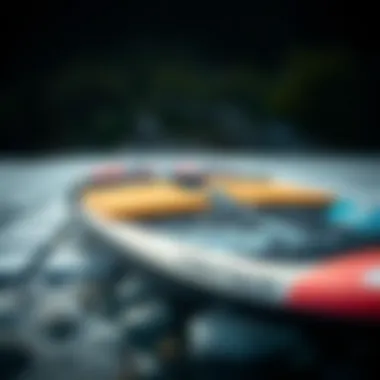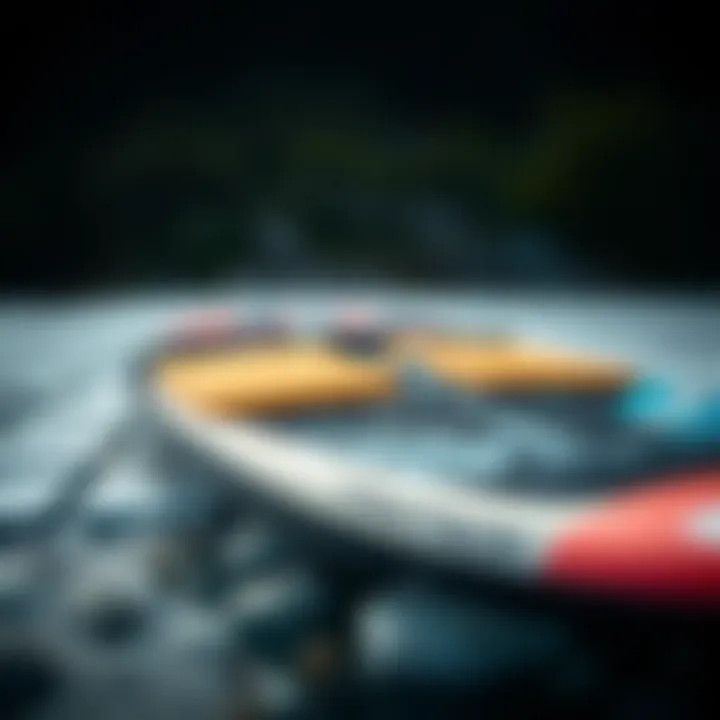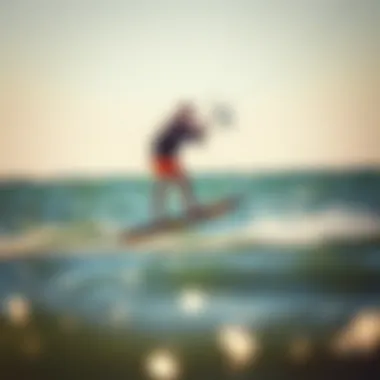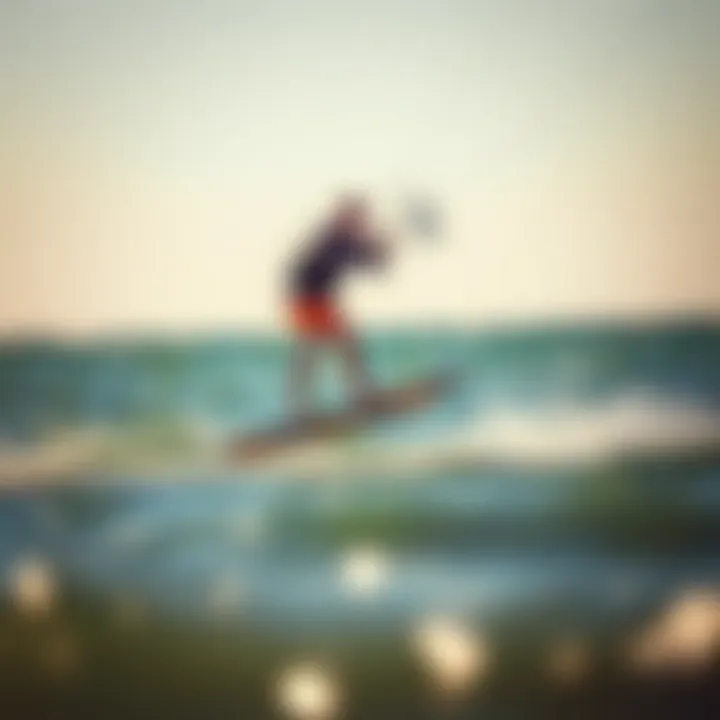Exploring Affordable Hydrofoil Boards: A Comprehensive Guide


Intro
The world of kiteboarding has expanded tremendously over the last few years, and hydrofoil boards are at the forefront of this evolution. They offer an exhilarating experience, enabling riders to glide over the water with ease, harnessing the power of the wind. However, for many enthusiasts, the idea of diving into hydrofoil riding can be daunting, especially when faced with the prices that often come with the latest equipment. This guide aims to illuminate the options available for those on a budget, providing insight into affordable hydrofoil boards.
Crafting an informed decision can feel like navigating a maze. The variety in design, materials, and performance can overwhelm even the most seasoned kiteboarders. However, fear not. By dissecting various brands and technologies, we’ll equip you with the knowledge needed to make wisely and confidently. Whether you’re a beginner just dipping your toes into the hydrofoil waters or an experienced rider looking for an economical upgrade, there’s something here for you.
Additionally, we’ll touch on essential maintenance tips and safety considerations, which are crucial for a fulfilling experience. Trends in hydrofoil technology are always shifting, so keeping your finger on the pulse can prove advantageous when selecting gear. Let’s embark on this journey and explore how affordable hydrofoil boards can elevate your kiteboarding adventure, ensuring you don’t skimp on quality or performance.
Prolusion to Hydrofoil Boards
Hydrofoil boards have been creating quite a buzz in the world of water sports. For anyone interested in kiteboarding or parasailing, understanding hydrofoil boards can greatly enhance your overall experience. These boards allow riders to glide above the surface, providing a unique riding experience that traditional boards simply can't match. In this section, we’ll dive into what hydrofoil boards are and why they matter, setting the stage for deeper exploration throughout the article.
Definition and Purpose
At its core, a hydrofoil board consists of a board and an attached hydrofoil, which is a wing-like structure submerged under the water. When the board gains speed, the hydrofoil lifts the board out of the water, reducing drag and allowing for seemingly effortless riding. This lift effect also grants the rider significantly reduced water resistance, making it possible to achieve higher speeds and ride in lighter winds than one would typically manage with standard boards.
The purpose of hydrofoil boards is not just to provide faster speeds; they also allow for a smooth, virtually silent ride, which can be a game-changer for those seeking a peaceful escape on the water. For kiteboarding enthusiasts, the ability to ride above the waves offers a thrilling new dimension to the sport.
How Hydrofoil Boards Differ from Traditional Boards
Hydrofoil boards stand apart from traditional boards in several key ways. Here’s a preliminary look:
- Lift Mechanism: Traditional boards rely entirely on their buoyancy to stay afloat, while hydrofoils use lift generated by the special design of their submerged wings.
- Speed and Maneuverability: Hydrofoil boards allow quicker acceleration and greater maneuverability. They can carve more sharply and navigate smaller turns due to their unique design.
- Riding Experience: The sensation of riding on a hydrofoil is often described as floating, which contrasts sharply with the more turbulent ride of a standard board. The smoother ride can appeal to both new riders and seasoned ones looking for a different experience.
"Riders often state, once you’ve experienced hydrofoiling, regular kiteboarding just doesn’t feel the same. It's almost like being airborne, thanks to reduced water contact."
In summary, hydrofoil boards introduce riders to a new realm of speed and sensation that standard boards can't deliver. For those eager to combine a love for adrenaline with the serenity of gliding atop the water, hydrofoils are a gateway worth investigating. They present opportunities for beginners and experienced kiteboarders to elevate their sport, both literally and figuratively. This guide is designed to arm you with vital knowledge as you consider diving into this exciting aspect of kiteboarding.
Understanding Hydrofoil Board Mechanics
Hydrofoil boards might seem like a new toy for adrenaline junkies, but understanding their mechanics is crucial for both safety and performance. This section dives into how these boards work, the intricate parts that make up hydrofoils, and the benefits of riding them. With an in-depth grasp of these elements, riders can enhance their experience on the water while making well-informed decisions about their gear.
The Hydrofoil Structure
The heart of any hydrofoil board lies in its structure. The components include the board, the mast, and most notably, the foil itself. Each piece plays a role in how efficiently and smoothly a rider can glide over the water.
Foil Types
When exploring foil types, there's a world of options out there. The two prominent styles are high aspect ratio foils and low aspect ratio foils. Each serves a different purpose and caters to varying riding styles.
- High Aspect Ratio Foils: These are recognized for their longer wings and thinner profiles, resulting in minimal drag and superior efficiency. Enthusiasts often favor them for racing or high-speed scenarios, as they can slice through the water like a hot knife through butter. However, they do require a certain level of skill to manage effectively, especially in choppy waters.
- Low Aspect Ratio Foils: These are shorter and wider, providing greater lift at lower speeds, making them an excellent option for newcomers learning the ropes. They are more forgiving, but can create more drag compared to their high aspect counterparts.
Choosing the right type of foil is crucial as it can significantly influence the riding experience.
Board Materials
The materials used in hydrofoil boards are pivotal to their performance and longevity. Common materials include foam composites, fiberglass, and carbon fiber. Each of these plays into the board's weight, durability, and responsiveness.
- Foam Composites: Typically heavier but more affordable, foam boards are a popular choice for budget-conscious buyers. They provide decent durability and are easy to replace in case of damage. One of the trade-offs, however, is that they might not offer the same performance enhancements as lighter materials.
- Fiberglass and Epoxy: This middle ground option is often found in a variety of shapes and sizes. They offer a balance of weight, stiffness, and performance, making them suitable for casual riders and seasoned enthusiasts alike. However, keep in mind that they can be more susceptible to dings.
- Carbon Fiber: For those willing to spend a little more, carbon fiber boards can deliver performance at a premium. They are incredibly lightweight and strong, resulting in rapid acceleration and sharp turns. The downside? Their price tag often makes them less accessible for those on a strict budget.
Understanding these materials leads to wiser choices when shopping for a hydrofoil board. Each material brings specific characteristics that can affect riding style, weight distribution, and overall performance.
Functionality of Foils in Water
Foils don’t just look fantastic; they fundamentally change the way a board interacts with water. As you glide, you might notice how a foil lifts the board above the surface, significantly reducing drag. This unique functionality allows riders not only to go faster but also to enhance their maneuverability.
For instance, during a typical ride, once the speed reaches a certain threshold, the front wing begins to lift. This life-changing lift can be felt immediately as the board rises from the water, creating a sensation of floating that is unmatched. This phenomenon can also be exploited during turns, providing more fluid movements and control over the ride.
In summary, grasping the mechanics behind hydrofoil boards is not just about understanding their anatomy; it’s about enhancing the overall experience. By familiarizing oneself with foil types and board materials, riders can make educated choices that will ultimately elevate their adventures on the water.


The Benefits of Using a Hydrofoil Board
Hydrofoil boards bring a new dimension to water sport enthusiasts looking to elevate their kiteboarding experience. They provide a unique blend of speed, agility, and a certain fluidity that traditional boards can’t match. For those contemplating whether to make the switch, understanding the benefits of using a hydrofoil board is crucial. This not only guides your purchasing decision but also shapes how you experience the water, especially in various conditions. Let’s break down the significant advantages that make hydrofoil boards so appealing.
Enhanced Speed and Performance
One of the primary attractions of hydrofoil boards is their ability to reach high speeds with minimal effort. Once you're up and foiling, the board lifts above the water surface, drastically reducing drag. This translates into a more efficient glide that lets you cover greater distances in less time.
The speed factor, of course, doesn’t just lie in the board design itself but also in how it interacts with your kite. A properly tuned kite coupled with the hydrofoil allows riders to harness more power from the wind, propelling them forward with incredible velocity.
Consider this: with traditional boards, waves and choppy waters can throw a wrench in your ride. But with a hydrofoil, you'll glide through rough patches as if they weren't there, turning potentially frustrating experiences into exhilarating rides. This performance boost opens opportunities to navigate where you may not have thought possible, such as riding on smaller wind days or in crowded spaces near shore.
"Hydrofoiling redefines your approach to kiteboarding, letting you skim over waves instead of crashing into them. It's like flying over water!"
Smooth Riding Experience
Moreover, hydrofoil boards deliver an almost surreal riding experience. As the board rises above the waves, riders gain a sense of freedom that traditional boards can't provide. The carving and turning become exceptionally smooth compared to other forms of riding. The lift generated by the foil creates a cushion effect, and it feels like floating on a soft carpet of water beneath you.
This smoothness not only enhances enjoyment but also contributes to a more forgiving ride. For those still learning the ropes, the hydrofoil can provide stability that encourages honing one's skills without the constant jarring that might come from hitting a wave too hard. You can focus on developing your technique without being bogged down by the water's surface imperfections.
In summary, the benefits of using a hydrofoil board extend well beyond basic performance metrics. From increased speed and agility to a smooth ride that promotes skill development, hydrofoils are revolutionizing how enthusiasts experience kiteboarding on the water. As you contemplate your next board purchase, these factors should weigh heavily in your decision-making process, ensuring you choose a board that truly enhances your time on the water.
Exploring Affordable Options
Diving into the realm of affordable hydrofoil boards sheds light on how those interested in kiteboarding can embrace the thrill without taking a major hit to their wallet. As the popularity of hydrofoilboards has surged, so has the availability of budget-friendly models that cater to those who may not want to break the bank. Understanding these options allows riders to make informed choices that balance quality with price.
Price Range Considerations
When curating a budget for a hydrofoil board, it’s crucial to grasp the nuances of pricing structures across different brands and models. Hydrofoil boards can range significantly in price, often influenced by design complexity, materials, and technology. For instance, a novice might consider spending between $800 to $1500 for a decent board, whereas intermediate to advanced riders often look at options in the $1500 to $3000 range for higher performance.
However, you'll find some hidden gems nestled in the lower price segments that perform surprisingly well. Brands have been stepping up their game to cater to cost-effective markets. Furthermore, it's beneficial to not just assess the upfront price but also include potential long-term costs.
- Maintenance: Less costly boards can sometimes require more care or may depreciate faster, leading to costs piling up down the line.
- Resale value: Certain boards keep their value better than others. Brands known for durability tend to fare better in resale, which can offset initial costs.
Thus, while on the surface it seems straightforward, successful navigators of the hydrofoil waters know that digging deeper into price considerations can lead to richer rewards.
Top Brands for Budget-Friendly Boards
Navigating through the vast sea of hydrofoil brands can be overwhelming, especially when shopping on a budget. However, a few names have emerged as reliable champions in this category, ideal for kiteboarders seeking affordability without sacrificing quality.
- Slingshot Sports: Renowned for their innovative designs and solid performance, Slingshot offers a range of boards that appeal to both newcomers and seasoned riders. Their commitment to durability makes them a favorite among budget-conscious consumers.
- North Kiteboarding: With a reputation for quality, North Kiteboarding’s entry-level boards are crafted to provide an enjoyable experience without compromising features that enhance performance.
- Fone: Fone’s hydrofoil boards are often highlighted for their versatility and stable ride. What’s more, they manage to pack a punch in terms of design and technology at a reasonable price.
- Liquid Force: Selling boards that cater particularly to enthusiasts who are just starting, Liquid Force provides models that hold up well under various conditions while still being wallet-friendly.
Choosing a reputable brand can elevate your overall riding experience, ensuring that even budget options hold their own in terms of performance.
By carefully considering price ranges and reputable brands, riders can find options that not only fit within their financial plans but also excel in functionality, offering all the thrills of hydrofoiling without the steep costs.
Evaluating Cheap Hydrofoil Boards
Evaluating cheap hydrofoil boards is more than just looking for a good deal. Selecting the right board requires careful consideration of several pivotal factors that can affect your riding experience. While budget is a primary consideration for many enthusiasts, it’s essential to weigh other aspects like performance, durability, and user feedback. This section delves into critical elements that define the quality of affordable hydrofoil boards, ensuring that your investment yields not only cost savings but also an enjoyable experience on the water.
Material Durability
When it comes to hydrofoil boards, the choice of materials can make or break your time on the water. Durability is of utmost importance because it directly influences how well the board can withstand the rigors of use and the potential wear and tear of the elements. Affordable hydrofoil boards often utilize materials like fiberglass, foam core, and various composites. Here are some insights to keep in mind:
- Fiberglass is popular for its balance between flexibility and strength. It can handle the impacts of choppy waters, but over time, exposure to UV light might weaken it.
- Foam cores tend to be lighter and enhance buoyancy. However, if the outer layer isn’t sturdy, this can lead to issues after repeated use.
- Composite materials, while sometimes pricier, often provide superior durability and are worth considering if you're keen on a board that lasts longer.
A well-constructed board can give you the confidence to push your limits. As the saying goes, "You get what you pay for," so be mindful not to skimp too much on this aspect.
User Reviews and Expert Recommendations
User feedback and expert insights play a crucial role in evaluating the effectiveness of cheap hydrofoil boards. Riding experience can greatly vary among users, and reading reviews can shed light on real-world performance and issues that might not be apparent through product descriptions. Here’s what to look for when researching:


- Performance Feedback: Look for comments on speed, stability, and ease of use. It’s wise to gather opinions from those with skill levels similar to your own.
- Durability Insights: Users often provide honest assessments of how well their board has withstood wear and tear over time. In particular, pay attention to mentions of repairs or maintenance needed after a period of use.
- Expert Consensuses: Sometimes, kiteboarding shops or enthusiasts' forums may feature articles or discussions from experts who share insights on the best budget boards. Explore platforms like Reddit and specialized kiteboarding forums for recommendations.
"A good hydrofoil board balances both price and performance. Don't lose sight of the fact that user experiences often highlight things that specs don't tell you!"
In sum, evaluating cheap hydrofoil boards demands thorough research and consideration of materials and user experiences. This diligence not only protects your investment but enhances that exhilarating feeling of gliding effortlessly across the water. By keeping a keen eye on performance and durability, as well as aligning with expert opinions, you can feel secure in your choice of equipment.
Common Mistakes When Choosing a Hydrofoil Board
When diving into the world of hydrofoil boards, it's all too easy to trip over a few common snags that could leave you with a board that doesn't quite fit your needs. This section peels back the layers on some of the prevalent pitfalls to avoid when you're on the hunt for an affordable hydrofoil. Understanding these mistakes can save not just money, but also time and frustration on the water. Here we'll explore how overlooking the right fit for your skill level and neglecting essential safety features can impact your hydrofoiling experience.
Overlooking Skill Level Compatibility
First up is the often-ignored factor of skill level. It's like trying to run before you can walk; if you pick a board that's designed for an expert when you're still learning the ropes, it can turn into a hassle rather than a thrill. Hydrofoil boards come in various shapes and forms tailored for different skill levels – from the novice who is just dipping their toes to the seasoned pro who can take on waves and gusts.
When selecting a board, take a moment to reflect: have you recently picked up kiteboarding or are you a regular at the local kite spot?
Key Points to Consider:
- Beginner Boards: Look for stability and ease of use. These boards often have a larger surface area and more forgiving foil setups.
- Intermediate Options: You might want something that offers a bit more performance with an optimal balance of control and speed.
- Advanced Choices: For those aiming to do tricks and maneuvers, a lightweight board with a specific foil style becomes necessary.
By ignoring this compatibility issue, not only can you find yourself struggling unnecessarily, but you might also peel off potential joy from what should be a fun pastime. In essence, always make sure the board matches your abilities.
Neglecting Safety Features
Next, let’s talk about safety—often an afterthought but should be front and center when choosing any sporting equipment.
Hydrofoil boards, while thrilling, can pose significant risks if proper safety measures aren’t in place. Many folks might get swept up in the allure of performance and forget to check whether the board includes essential safety features. Here's a checklist to guide you:
- Leash Systems: Make sure the board includes a leash or is compatible with one, to avoid it getting away from you in the water.
- Padding and Grip: Delve into the features that provide grip; you want to avoid slips that can lead to spills, in particular when primo conditions can lead to wild rides.
- Impact Resistant Materials: Opt for boards made with materials such as polyurethane or EVA foam to cushion against hard knocks.
Keep in mind, safety gear does not stop at the board itself. Wearing a helmet or impact vest can safeguard against falls and bumps. It’s wise to look at both the board and what you’re wearing to keep your hydrofoil rides as enjoyable and accident-free as possible.
In the quest for a suitable hydrofoil board, be cognizant of these pitfalls. Missing the mark here may not just mean you’ve bought the wrong item; it can also make your time on the water less enjoyable and potentially unsafe. Stay sharp and plan wisely!
Maintenance Tips for Affordable Hydrofoil Boards
Caring for your hydrofoil board is not just about prolonging its life; it’s about maximizing your enjoyment on the water. Maintaining your board properly means you can ride with confidence, knowing that your equipment is ready to perform. If your hydrofoil board is taken care of, you’ll find that it delivers better performance, reduces the risk of mishaps, and can even save you costs in the long run by delaying the need for repairs or replacements.
Routine Inspections and Care
Regular inspections are the backbone of effective board maintenance. You don’t want to be that person who discovers a critical flaw right before hitting the water. Inspecting your board involves several key elements:
- Check the Foil: Ensure that the foil remains securely attached to the board. Tighten screws and bolts if they feel loose.
- Look for Dings and Scratches: Examine the bottom of the board for any impact damage. Small dings can develop into bigger problems if left unattended.
- Evaluate the Condition of the Hydrofoil Blades: Watch for signs of wear on the blades, as they are crucial for smooth movement through water.
- Inspect Sealants and Coatings: Ensure any seals or protective coatings are intact to prevent water damage or rot.
During your routine inspections, keep a checklist for yourself. Write down what you observe in a maintenance notebook if you prefer being methodical. This will help in remembering what needs fixed and when.
Storage Practices
Proper storage can be a game-changer when it comes to lengthening the lifespan of your hydrofoil board. You want to avoid storing it in conditions that damage it over time. Here are some best practices for storage:
- Store Indoors: Ideally, keep your board indoors when not in use. Direct sunlight can warp materials and compromise their integrity.
- Avoid Moist Environments: High humidity can encourage mold and mildew, especially if you have any foam material in your board.
- Use a Board Bag: An appropriate board bag can protect your board from scratches and dings, while also making transport easier.
- Keep It Flat: Store your board flat; leaning it against a wall could cause warping.
Always remember: Better maintenance leads to a better riding experience. Neglect is the enemy!
Take these simple guidelines to heart, and you will not only ensure your hydrofoil board remains in peak condition but also improve your confidence and skills on the water.
Safety Considerations for Hydrofoil Riding
When engaging in hydrofoil riding, safety is a critical aspect that cannot be overlooked. Hydrofoil boards can be quite exhilarating, but they also pose unique risks due to their speed and the nature of riding above the water's surface. Ensuring that you have the right safety measures and gear can enhance your experience and minimize the chance of accidents.


Hydrofoil riding often takes place in open water settings where the environment can change rapidly. Being prepared not just protects you, but also allows for greater enjoyment of the sport. It's not just about positioning yourself on the board; it's about being mindful of everything from your surroundings to your physical condition.
Recommended Gear and Protection
Investing in proper gear is non-negotiable for anyone serious about hydrofoil riding. Not only does good gear improve performance, but it also significantly enhances safety. Here’s a closer look at what you should consider:
- Helmet: Wearing a helmet is essential. It protects your head from unexpected falls or collisions. Look for a lightweight and impact-resistant model tailored for water sports.
- Impact Vest: An impact vest can absorb shock from falls, making a big difference in how you feel when you hit the water.
- Wetsuit or Drysuit: Depending on water temperature, wearing a wetsuit or a drysuit can help keep you warm and protect your skin from cuts and abrasions.
- Footwear: Non-slip water shoes help with grip and protect your feet from sharp objects lurking beneath the surface.
- Leash: A luxury some might overlook, a board leash is vital. It prevents the board from drifting away from you after a fall, making it easier to get back on quickly.
Remember, gear is your first line of defense. Choosing quality over cost can be a game changer when it comes to safety.
What to Avoid While Riding
There are various pitfalls that new riders might encounter on the water which can lead to accidents or injuries. Steering clear of these mistakes is crucial:
- Poor Weather Conditions: Riding in strong winds or choppy waters can lead to loss of control. Always check weather conditions and choose days with calm winds.
- Neglecting Equipment Checks: Regularly inspect your hydrofoil board and equipment. Look for any signs of wear or malfunction, especially screws on the foil or damage on the board’s surface.
- Crowded Areas: Avoid riding in congested waters where there could be other watercraft, swimmers, or obstacles. This can help you maintain control and reduce the likelihood of collisions.
- Ignoring Personal Limits: Know your skill level. Pushing yourself too hard, too fast, can lead to unnecessary accidents, especially in the early stages of learning.
- Riding Alone: It's often advised to ride with a buddy. If an accident were to occur, having someone around can make a world of difference in terms of prompt assistance.
Safety isn’t just about protecting yourself on the water; it’s also about being responsible towards others enjoying the same space.
In summary, keeping safety in mind while enjoying hydrofoil riding ensures that you maximize fun while minimizing risks. Remember, each ride is a new experience, so be smart and stay alert!
Trends in Hydrofoil Board Technology
As kiteboarding enthusiasts dive deeper into the realm of hydrofoil boards, it becomes essential to stay in the loop with the latest trends in technology. These advancements not only enhance performance but also improve safety and accessibility for riders at various skill levels. Understanding the emerging technologies in hydrofoil boards can be the key to finding an affordable yet high-quality option that suits individual preferences.
Innovations in Design
The design of hydrofoil boards has witnessed significant changes in recent years. Manufacturers are experimenting with shapes, sizes, and materials to create boards that deliver enhanced performance. For example, the introduction of shorter, wider boards has made it easier for novice riders to balance while learning the ropes.
Furthermore, developments in materials like carbon fiber or hybrid composites are gaining traction. These materials offer a lightweight feel, making it easier to maneuver without compromising durability. When looking for an affordable hydrofoil, considering boards manufactured with these advanced materials can lead to better performance on the water.
- Key Considerations in Design:
- Board Shape: Wider designs provide stability for beginners.
- Material Composition: Hybrid constructions can enhance performance at lower costs.
- Foil Setup: Innovative layouts can drastically improve lift and handling.
Innovation has always been a cornerstone in the evolution of hydrofoiling; keeping abreast of these trends can transcend your riding experience.
Future of Affordable Hydrofoils
Looking ahead, the future of affordable hydrofoils appears bright. As technology becomes more advanced and production processes streamline, costs are expected to decrease. This means that more riders will have access to high-quality boards without breaking the bank.
One significant trend is the rise of customizable options. Soon, riders might be able to mix and match components based on personal riding styles, allowing for a uniquely tailored experience. This aspect not only increases performance but also provides an opportunity for individual expression.
Additionally, manufacturers are paying closer attention to ecological impacts. There’s growing interest in using sustainable materials and manufacturing processes. This focus will attract environmentally conscious riders who are more mindful of their purchases.
End
As we wrap up this comprehensive dive into affordable hydrofoil boards, it’s vital to reinforce the significance of selecting the right board. The conclusion serves as an opportunity to encapsulate key insights and offer a pathway for kiteboarding enthusiasts to make well-informed decisions.
Choosing a hydrofoil board isn’t merely about aesthetics or brand reputation; it’s about recognizing the intersection of your skill level, riding style, and budget constraints. This article has outlined various aspects, from the mechanics of hydrofoil design to maintenance practices. All these elements are crucial for enhancing your experience on the water.
Here are pivotal factors to consider:
- Budget: Weighing cost against performance is fundamental. An affordable board shouldn’t compromise quality.
- Materials and Durability: Ensuring the board is made from durable materials affects longevity and performance.
- User Reviews: Learning from others’ experiences can offer insights beyond manufacturer specifications.
In essence, the right hydrofoil board leads to more enjoyable rides, safety, and ultimately, improvement in skills over time. Without a doubt, making an informed choice promises a gratifying experience on those sun-drenched waters.
Summary of Key Points
- Understanding Hydrofoil Boards: It’s pivotal to grasp the fundamental differences between hydrofoil and traditional boards, which significantly impacts performance and the riding experience.
- Evaluating Affordable Options: Price doesn’t always reflect quality. Exploring various brands and their offerings can unveil hidden gems that fit various budgets.
- Maintenance and Safety: Regular upkeep of your board enhances durability while incorporating safety gear is essential for protecting yourself during rides.
- Trends in Technology: Staying updated with innovations ensures you're aware of the latest advancements, providing opportunities to enhance your performances.
Final Thoughts on Choosing the Right Hydrofoil Board
Navigating the purchase of a hydrofoil board might feel daunting, especially for those new to the thrilling world of kiteboarding. However, by considering the discussions and insights provided, you are equipped to tackle this journey systematically.
Begin by assessing your own skill level and preferences. If you’re a novice, a board designed for easier maneuverability could be beneficial, allowing you to gain confidence. On the other hand, seasoned riders may wish to explore models that prioritize speed and agility.
As technology advances, so too do opportunities for acquiring quality boards at reduced prices. Engage in user reviews and expert suggestions, and don’t shy away from reaching out to community forums. This not only benefits your decision-making process but also connects you with like-minded individuals who share your passion.



